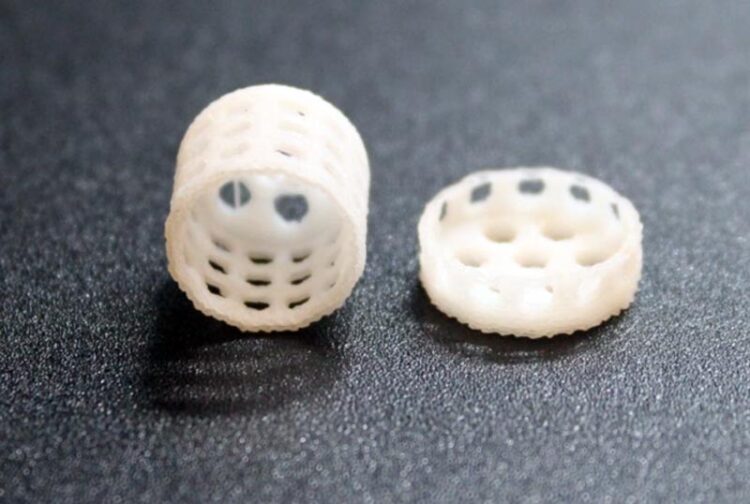3D-printed scaffold could improve breast reconstruction results

Photo of 3D-printed P4HB empty scaffold for nipple reconstruction
Credit: Weill Cornell Medicine; Spector Lab
In a study, published Mar. 8 in the Journal of Plastic and Reconstructive Surgery, Dr. Jason Spector, professor of surgery (plastic surgery) at Weill Cornell Medicine and chief of the Division of Plastic and Reconstructive Surgery at Weill Cornell Medicine and NewYork-Presbyterian/Weill Cornell Medical Center, and his colleagues report the development of a nipple reconstruction technique using a 3D-printed scaffold made of a polymer already widely used in surgical devices. Then, they demonstrate in a preclinical model that the dissolvable scaffold and the body’s healing processes create nipples that not only look and feel real but also, most importantly, maintain long lasting projection unlike previous reconstruction approaches.
“We’ve developed a new approach to engineering nipples for breast reconstruction that we think will have a very positive impact on the lives of patients who’ve suffered through the effects of breast cancer and mastectomy,” said Dr. Spector.
Rebuilding the nipple is often the last step in breast reconstruction after a mastectomy, but it is also one of the most challenging. In a small proportion of cases, surgeons may be able to preserve the patient’s nipple, but in most cases, the surgeon must recreate a nipple from skin tissue. Currently, surgeons use a variety of approaches to reconstruct a nipple using flaps of the patient’s skin. However, healing processes often cause the reconstructed nipple to flatten over time and it may become completely flat in a year or two. The result can be very disappointing for patients, Dr. Spector said.
Surgeons have tried to preserve the nipple shape longer with fillers used in facial surgeries, but the fillers break down and disappear over time. They’ve also tried using cartilage or other stiff materials that don’t feel as natural. Dr. Spector and his team set out to engineer a better alternative.
Dr. Spector partnered with a company called Tepha, Inc., which creates a polymer called Poly-4-Hydroxybutyrate (P4HB) that is already widely used in surgical meshes and other medical devices. The team, including lead author Dr. Xue Dong, a postdoctoral associate in Dr. Spector’s lab, 3-D printed the polymer into a scaffold recreating the size and shape of a nipple. Using an animal model, they showed that over time the scaffold breaks down, and the body’s natural healing process re-fills the space with fatty and vascular tissues typically found in a nipple.
“The best tissue engineer is the body itself,” Dr. Spector said. “If you create the right conditions and use the right scaffold in the right size, the body itself will engineer the tissue.”
They took a series of biomechanical measurements that confirmed that the reconstructed nipple had biomechanical characteristics comparable to the real thing. They are currently fine-tuning their technique in a second study and hope to reduce the time necessary for the scaffold to dissolve from 6 months to 3 months. If they are successful, Dr. Spector thinks the device could be very quickly available for women undergoing mastectomy because the material is already safe and widely used in humans and could go through a rapid process for US Food and Drug Administration clearance.
The 3-D printed scaffolds could be made in a range of sizes and shapes to meet the individual needs of patients or even custom printed to match the remaining nipple in a patient who has undergone a unilateral mastectomy. Dr. Spector said surgeons might also use the scaffold to reduce flattening after nipple-sparing breast reconstruction.
“This is an important step in helping patients who choose to have breast reconstruction after mastectomy feel whole again,” Dr. Spector said.
Journal: Plastic and Reconstructive Surgery Global Open
Article Title: Long-term Maintenance of Projection of Nipples Reconstructed Using 3D-printed Poly-4-Hydroxybutyrate (P4HB) Bioabsorbable Scaffolds
Article Publication Date: 8-Mar-2023
Media Contact
Barbara Prempeh
Weill Cornell Medicine
bap4004@med.cornell.edu
Cell: 917-242-1561
All latest news from the category: Medical Engineering
The development of medical equipment, products and technical procedures is characterized by high research and development costs in a variety of fields related to the study of human medicine.
innovations-report provides informative and stimulating reports and articles on topics ranging from imaging processes, cell and tissue techniques, optical techniques, implants, orthopedic aids, clinical and medical office equipment, dialysis systems and x-ray/radiation monitoring devices to endoscopy, ultrasound, surgical techniques, and dental materials.
Newest articles

High-energy-density aqueous battery based on halogen multi-electron transfer
Traditional non-aqueous lithium-ion batteries have a high energy density, but their safety is compromised due to the flammable organic electrolytes they utilize. Aqueous batteries use water as the solvent for…

First-ever combined heart pump and pig kidney transplant
…gives new hope to patient with terminal illness. Surgeons at NYU Langone Health performed the first-ever combined mechanical heart pump and gene-edited pig kidney transplant surgery in a 54-year-old woman…

Biophysics: Testing how well biomarkers work
LMU researchers have developed a method to determine how reliably target proteins can be labeled using super-resolution fluorescence microscopy. Modern microscopy techniques make it possible to examine the inner workings…





















